
The wire-tailed swallow is a small passerine bird in the swallow family. It has two subspecies: H. s. smithii, which occurs throughout Africa, and H. s. filifera, which is found in southern and southeastern Asia. It is mainly resident, but populations in Pakistan and northern India migrate further south in winter. The genus name Hirundo is the Latin word for swallow. The species name smithii commemorates Christen Smith, a Norwegian botanist and geologist.
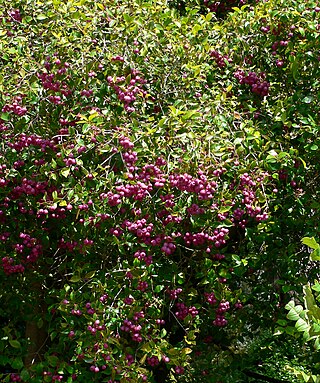
Syzygium smithii is a summer-flowering, winter-fruiting evergreen tree, native to Australia and belonging to the myrtle family Myrtaceae. It shares the common name "lilly pilly" with several other plants.It is planted as shrubs or hedgerows, and features: rough, woody bark; cream and green smooth, waxy leaves; flushes of pink new growth; and white to maroon edible berries. Unpruned, it will grow about 3–5 m (9.8–16.4 ft) tall in the garden.

Gekko smithii, commonly known as Smith's green-eyed gecko or the large forest gecko, is a species of lizard in the family Gekkonidae. The species is native to mainland Southeast Asia and Indonesia.

The brown roofed turtle is a species of turtle in the family Geoemydidae. The species is endemic to South Asia. Two subspecies are recognized.

The ruddy mongoose is a mongoose species native to hill forests in India and Sri Lanka.
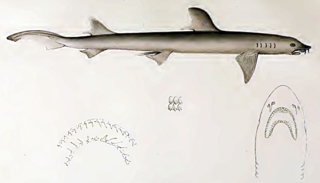
The barbeled houndshark is a species of ground shark and the only member of the family Leptochariidae. This demersal species is found in the coastal waters of the eastern Atlantic Ocean from Mauritania to Angola, at depths of 10–75 m (33–246 ft). It favors muddy habitats, particularly around river mouths. The barbeled houndshark is characterized by a very slender body, nasal barbels, long furrows at the corners of the mouth, and sexually dimorphic teeth. Its maximum known length is 82 cm (32 in).

The desert musk shrew is a species of mammal in the family Soricidae. It is found in Ethiopia, Senegal, and possibly Somalia. Its natural habitat is dry savanna. It was named after the 19th-century American explorer of Eastern Africa, Arthur Donaldson Smith.

The Smith's shrew is a species of mammal in the family Soricidae. It is endemic to southwest China, living primarily in mountainous broad-leaved forests at elevations of 900–3000 meters.

Eucalyptus smithii, commonly known as the gully gum, gully peppermint, blackbutt peppermint, or ironbark peppermint, is a species of medium-sized to tall tree, sometimes a mallee, that is endemic to southeastern Australia. It has rough, compact bark on the trunk, smooth ribbony bark above, narrow lance-shaped adult leaves, flower buds in groups of seven, white flowers and cup-shaped, bell-shaped or hemispherical fruit.

Alexander Hanchett Smith was an American mycologist known for his extensive contributions to the taxonomy and phylogeny of the higher fungi, especially the agarics.

The Bankeraceae are a family of fungi in the order Thelephorales. Taxa are terrestrial, and ectomycorrhizal with plant species in families such as Pinaceae or Fagaceae. The family was circumscribed by Marinus Anton Donk in 1961. According to a 2008 estimate, the family contains 6 genera and 98 species.
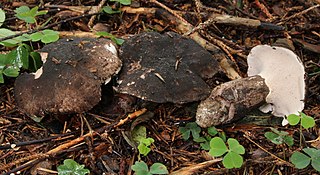
Boletopsis is a genus of mycorrhizal fungi in the family Bankeraceae. The genus was circumscribed by Swiss mycologist Victor Fayod in 1889, with Boletopsis leucomelaena as the type species.

Mycocepurus smithii is a species of fungus-growing ant from Latin America. This species is widely distributed geographically and can be found from Mexico in the north to Argentina in the south, as well as on some Caribbean Islands. It lives in a variety of forested habitats and associated open areas. Two studies published in 2009 demonstrated that some populations of the species consist exclusively of females which reproduce via thelytokous parthenogenesis. A detailed study found evidence of sexual reproduction in some populations in the Brazilian Amazon. Accordingly, M. smithii consists of a mosaic of sexually and asexually reproducing populations. In asexual populations all ants in a single colony are female clones of the queen. Inside the colony, the ants cultivate a garden of fungus grown with pieces of dead vegetable matter, dead insects, and insect droppings.
Gilbert Morgan Smith was a botanist and phycologist, who worked primarily on the algae. He was best known for his books, particularly the Freshwater Algae of the United States, the Marine Algae of the Monterey Peninsula and the two volumes of Cryptogamic Botany.

Boletopsis nothofagi is a fungus in the family Bankeraceae. The fungus forms grey fruit bodies that grow in clusters. Like all species of Boletopsis, it has a porous spore-bearing surface on the underside of the cap, but differs from other species of Boletopsis by having characteristics such as elongated spores and a green discoloration when stained with potassium hydroxide. Boletopsis nothofagi is endemic to New Zealand and has a mycorrhizal association with red beech. It is unknown when exactly the fungus forms its fruit body, but it has so far been found solely in May, during autumn in the Southern Hemisphere.

Boletopsis leucomelaena is a species of hydnoid fungus in the family Bankeraceae. It was originally described in 1801 as Boletus leucomelas by Christian Hendrik Persoon. Swiss mycologist Victor Fayod transferred it to Boletopsis in 1889. The fungus is listed as a priority species in the United Kingdom Biodiversity Action Plan. B. leucomelaena is found in the Pacific Northwest region of North America, in Japan, and throughout Europe, although it is less common than the lookalike B. grisea.
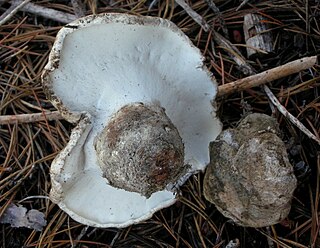
Boletopsis grisea is a species of fungus in the family Bankeraceae. The fruit bodies are gray, fleshy polypores that grow on the ground in a mycorrhizal association with Scots pine. It is found in Asia, North America, and Europe.
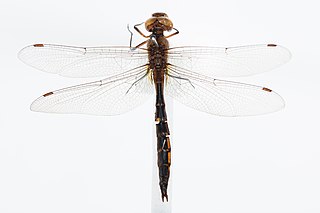
Procordulia smithii, commonly known as Smith's dragonfly or the ranger dragonfly, is a species of dragonfly that is endemic to New Zealand, as is its close relative Procordulia grayi.

John Bernhardt Smith was an American professor of entomology who specialized in systematics and economic entomology while also serving as the State Entomologist of New Jersey. Smith is remembered in insect taxonomy for the conflict that he had with Harrison Dyar.
Pleurotus smithii is a species of fungus in the family Pleurotaceae, described as new to science by mycologist Gastón Guzmán in 1975. Like other species of the Pleurotus cystidiosus clade, it has an anamorphic form, named Antromycopsis guzmanii. P. smithii can be distinguished from P. cystidiosus by lack of pleurocystidia or them being only present in young stages as cystidioid elements, short hyphal segments of the conidiophores in the anamorph, and long subcylindrical cheilocystidia in the teleomorph form.

















